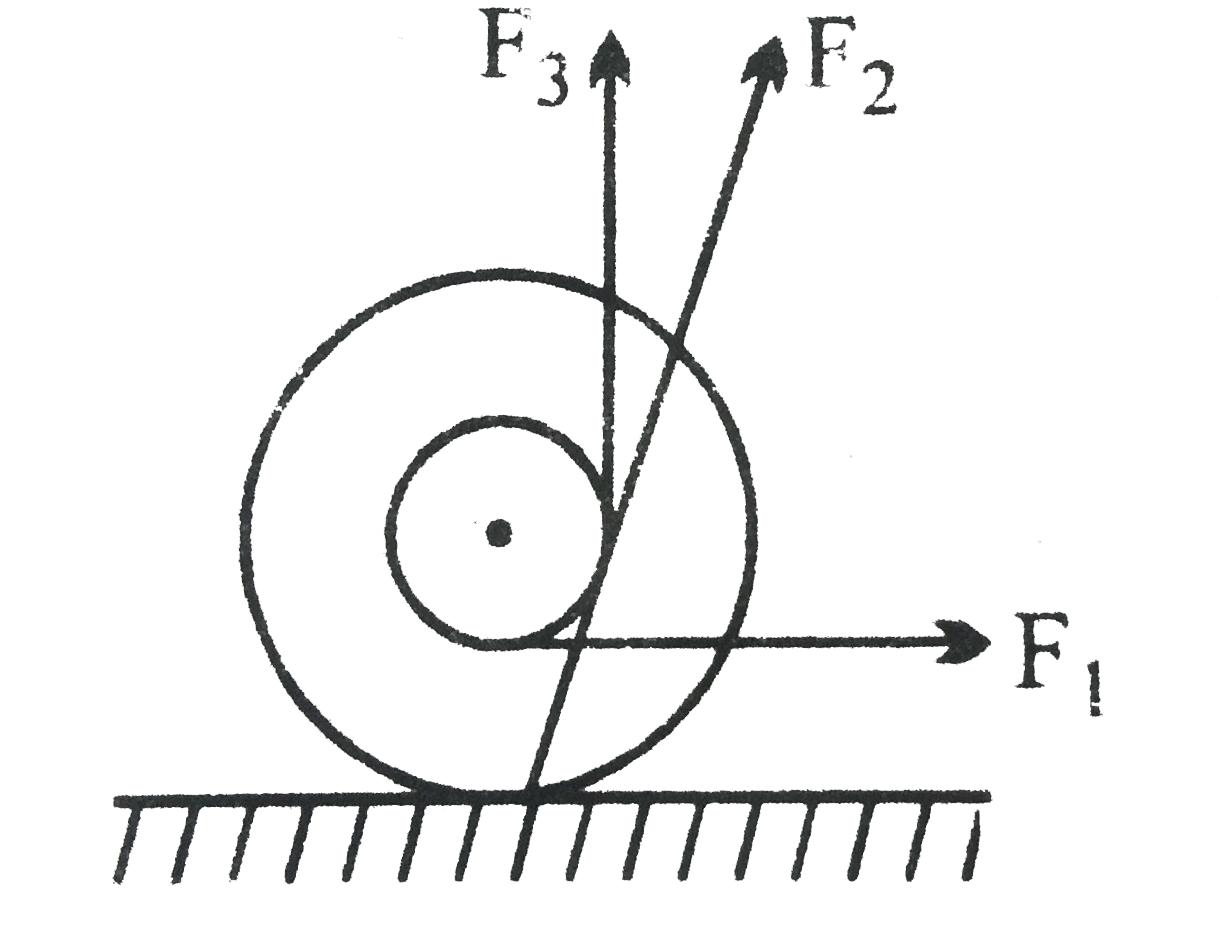A yo-yo is resting on a perfectly rough horizontal table. Forces F1,F2 and F3 are applied separately as shown. The correct statement is
 .
.
When F3 is applied the centre of mass will move to the right.
When F2 is applied the centre of mass will move to the left.
When F1 is applied the centre of mass will move to the right.
When F2 is applied the centre of mass will move to the right.
The correct Answer is:C
Similar Questions
A yo-yo is resting on a perfectly rough horizontal table . Forces F1,F2andF3 are applied seqarately as shown . The correct statement is

View SolutionA spol is lying on a rough horizontal surface. Forces F1,F2,F3 and F4 act in different directions, as represented in column I. Match the information in column I with II.


View Solution
Knowledge Check
In the figure , two identical blocks A and b of wight ω each aare lying a rest on a rough horizontal surface they can just be pulled by applying forces F1andf2(=5F1) choose the correct the correct statement (s)
 AThe value of frictical force on block B is equal to five tes the value of frictional force on A when they just start moving.BThe Co-efficient of friction is equal to 89CThe radio F1W is equal to 23DThhe value of friiional forces on the block are equal.
AThe value of frictical force on block B is equal to five tes the value of frictional force on A when they just start moving.BThe Co-efficient of friction is equal to 89CThe radio F1W is equal to 23DThhe value of friiional forces on the block are equal.A triangular block mass m rests on a fixed rough inclined plane having friction coefficient μ with the block. A horizontal force F is applied to it as shown in figure below, then the correct statement is :
 AFriction force is zero when Fcosθ=mgsinθBThe value of limiting friction is μ(mgsinθ+Fcosθ)CNormal reaction on the block is Fsinθ+mgcosθDThe value of limiting friction is μ(mgsinθ−Fcosθ)
AFriction force is zero when Fcosθ=mgsinθBThe value of limiting friction is μ(mgsinθ+Fcosθ)CNormal reaction on the block is Fsinθ+mgcosθDThe value of limiting friction is μ(mgsinθ−Fcosθ)A triangular block of mass m rests on a fixed rough inclined plane having friction coefficient μ with the block. A horizontal forces F is applied to it as shown in figure below, then the correct statements is:
 AFriction force is zero when Fcosθ=mgsinθBThe value of limiting friction is μ(mgsinθ+Fcosθ)CNormal reaction on the block is Fsinθ+mgcosθDThe value of limiting friction is μ(mgsinθ−Fcosθ)
AFriction force is zero when Fcosθ=mgsinθBThe value of limiting friction is μ(mgsinθ+Fcosθ)CNormal reaction on the block is Fsinθ+mgcosθDThe value of limiting friction is μ(mgsinθ−Fcosθ)
Two rectangular blocks A and B are placed on a horizontal surface at a very small separation. The masses of the blocks are mA=4 kg and mB=5 kg. Coefficient of friction between the horizontal surface and both the blocks is μ=0.4. Horizontal forces F1 and F2 are applied on the blocks as shown. Both the forces vary with time as F1=15+0.5t
F2=2t
Where ‘t’ is time in second.
Plot the variation of friction force acting on the two blocks (fAandfB) vs time till the motion starts. Take rightward direction to be positive for B and leftward direction to be positive forfA.

View SolutionA wooden block of mass m resting on a rough horizontal table (coefficient of friction =μ ) is pulled by a force F as shown in figure.The acceleration of the block moving horizontally is:

View SolutionA uniform cube of side a and mass m rests on a rough horizontal table. A horizontal force F is applied normal to one of the faces at a point that is directly above the centre of the face, at a height 3a/4 above the base. The minimum value of F which the cube begins to tip about the edge is ....(Assume that the cube does not slide).
View SolutionA uniform cube of side a and mass m rests on a rough horizontal table. A horizontal force F is applied normal to one of the faces at a point directly above the centre of the face, at a height 3a4 above the base. What is the minimum value of F for which the cube begins to tip about an edge?
View SolutionA uniform cube of side a and mass m rests on a rough horizontal table. A horizontal force F is applied normal to one of the faces at a point directly above the centre of the face, at a height 3a4 above the base. What is the minimum value of F for which the cube begins to tip about an edge?
View Solution
